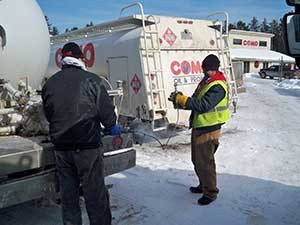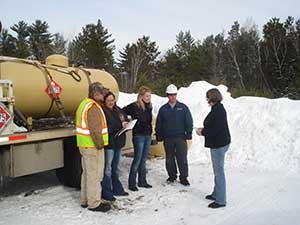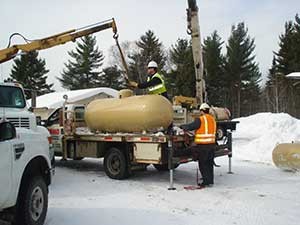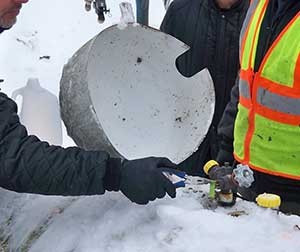Ammonia contamination episodes bring acute safety, operational risks
An incident involving ammonia contamination can create caustic consequences for your propane business.
“It can be a business killer, as the comprehensive cost of action and remediation is an immediate cash-flow impact of extreme proportion. Worse, there could be the risk of injurious or fatal impacts to people with no warning,” says Jim Olson, vice president of safety and assets at Como Oil and Propane Co., which has nine locations throughout Minnesota and Wisconsin.
“Nobody expects this to happen to them, and when it does, it’s such a shock,” echoes Will Norman, Como’s co-president, COO and immediate past president of the Minnesota Propane Association (MPA).
Following a frightening and costly contamination incident, Como is presenting ammonia awareness sessions for the propane industry, describing the lessons learned and strategies to employ when a crisis strikes.

Will Norman, Como’s co-president, COO and immediate past president of the Minnesota Propane Association.
“It’s a really hot topic,” Norman says. “We’re reaching out and giving presentations [to spread the message].People are extremely interested, and people are asking excellent questions.”
Jerry Kowalski of ProTech Resources, who serves as the MPA’s training director, has also been conducting classes throughout the Midwest.
“In the agricultural states, they are aware of anhydrous ammonia, but they do not understand the seriousness of the dangers it presents to their employees. If they come in contact with anhydrous ammonia in concentrations of over 300 [parts per million], it could kill someone,” Kowalski says, citing a situation that occurred in April regarding a new transport driver who accidentally unloaded anhydrous ammonia into a propane storage tank.
Olson recalls a long-ago incident in which a refrigeration maintenance worker “took a full-on blast of ammonia to his face and upper torso” when a valve handle broke.
“The entire facility was evacuated, and when we dragged the guy outside the course of first aid was to nearly drown him in water to mitigate the physical effects of the ammonia,” he recalls. “It included burns to soft tissue and particularly the need for flushing eyes, mouth and mucous membranes – which ammonia seeks out as it looks for moisture. He came out OK, but it was brutal to watch throughout the incident and his recovery.”

Como field operations personnel collect propane vapor for testing. Photo courtesy of Como Oil and Propane
Propane retail businesses should have a standing crisis/disaster plan in place that covers all contingencies, according to Norman. Additionally, he urges staffers to be properly informed of updated response scenarios while ownership reviews the company’s insurance policies.
“I’ve been encouraging all marketers to reach out to their insurance brokers to see what types of coverage they have,” Norman says. “That’s the banner I’m trying to raise at the local, state and national levels. Most marketers believe they have insurance coverage for this type of tragedy, but most of them don’t.”
“No one manages their business based on the lightning-strike possibility of happenstance, such as a bulk plant being contaminated by anhydrous ammonia,” Olson says. “This is one such happenstance issue that every propane marketer ought to prep and plan for. Every marketer needs to run, not walk, to a phone and call their insurance carrier and ask specifically which and how many areas of coverage protect against such contaminated product and its far reach throughout operations. We found loopholes and misconstrued areas of understood coverage in many areas of product, equipment and liability.”
Como’s previous policy covered less than 20 percent of the damages incurred when it experienced a major ammonia contamination problem in February 2014. It happened in the heart of the heating season, during one of the worst winters on record. The aftermath took six weeks to resolve.
“Snow was up to our hips” amid constant temperatures of minus-20 degrees, says Norman, as Como’s entire workforce rallied to deal with the contamination’s far-reaching impact while also struggling to maintain normal operations.
At Como’s Cable, Wis., facility, a driver with more than 20 years of experience observed that while the propane he was loading into his bobtail from one of the company’s plants had odorant, the smell resembled that of ammonia in nature.
“His report was met with some skepticism as our own transport company does not haul anhydrous ammonia, nor anywhere in our service territories is there strong agriculture use and hauling of that product,” Olson says. “In fact, other than CETP classes where we had heard of ammonia contamination of LP systems, no one at Como had firsthand knowledge or experience with the product at any level.”
Based on the driver’s credibility, product draw was suspended until the next morning when testing could commence. The presence of ammonia was confirmed. The rough winter had Como hauling propane from long distances via a third-party transport, and Como alleges that the truck’s improperly cleaned tank still contained ammonia residue when it was filled with LP gas.
It soon became apparent that near-catastrophic conditions were occurring and Como needed to move quickly. An existing crisis/disaster plan was implemented, securing key team members with set roles.

The Como team confirms customer locations impacted by contamination. Photo courtesy of Como Oil and Propane
“Those assignments included sourcing experts and those with experience with ammonia contamination. We contacted insurance and other key parties,” Olson says. “We assigned CSR and field operation teams to source all data on loads into and out of the plant, including exacting timelines and delivery locations made with product from that bulk plant in a selected ‘reasonable’ window.
“We sent teams out with data on those deliveries and started a grid of testing at customer locations,” Olson says. “With positive tests for ammonia, we quickly discerned which day and which carrier the suspect contaminated product arrived at our bulk plant, as well as each and every date, time and location delivered from that impacted propane.”
More than 100,000 gallons of propane were ultimately discarded.
Along with personal health concerns, ammonia attacks brass and copper fittings, rendering risks to equipment functionality over time.
“It quickly became clear to us that we had to remove all the affected customer tanks out in the field,” Norman says.
Three full bobtails had to be cleaned out and the fittings replaced, plus two 30,000-gallon storage tanks were contaminated in addition to the 87 tanks installed in customers’ yards. The residential vessels had to be replaced; they were hauled away from the properties while still containing propane and taken to a field for flaring.

Como’s field operations crew loads tanks for customers affected by the 2014 incident. Photo courtesy of Como Oil and Propane
“Cleaning the inside of 500- to 1,000-gallon tanks is simply cost prohibitive,” Olson says. “We pulled all valves and appurtenances, destroyed those, and the tanks were sold as scrap metal.”
According to Olson, some people believe that if you run enough residual loads of LP gas through a vessel, relative to the level of ammonia contamination, it will dissipate the ammonia contaminant from the metal walls of the tank.
“For obvious reasons, no responsible party is going to test that model, as you would never know for sure when all the contaminant is flushed and the product remains suspect for the duration,” Olson says. “We chose what we believed was the only action – to remove the vessels as expeditiously as we could from operational use.”
“We mobilized boom trucks, and we just went to work,” Norman says.
Letters were sent and phone calls made to impacted customers.
“They were very appreciative of our quick response and that we were able to do it without disrupting their heat,” Norman says.
Como employees from other branches were brought in to assist with the situation, staying in hotels and working long, exhausting hours.
“We had a lot of heroes; the reaction from our employees was phenomenal,” Norman says, also crediting the MPA and a vast assortment of industry colleagues with providing valued aid.
“All of our vendors stepped up and we were able to get all the tanks we needed,” he adds. “We had 15 percent of our fleet down in one of the worst winters in 40 years, and we even had competitors loaning us bobtails so we could continue to take care of our customers.”
Anhydrous ammonia
According to the Missouri Propane Gas Commission, anhydrous ammonia (NH3) is used as a fertilizer, refrigerant and chemical feedstock. Because it is transported in cargo tanks also used to transport LP gas, contamination of LP gas is possible if transporters fail to use proper procedures for cleaning cargo tanks.


















